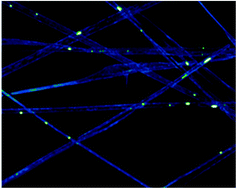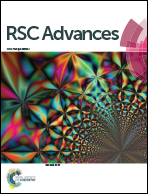Amino acid-based poly(ester amide) nanofibers for tailored enzymatic degradation prepared by miniemulsion-electrospinning†
Abstract
Novel enzyme loaded scaffolds with enzyme-responsive degradable properties for drug delivery are prepared by an original inverse-miniemulsion electrospinning method. Miniemulsions with aqueous nanodroplets containing different enzymes, i.e. lipase or α-chymotrypsin, and a fluorophore are electrospun with a solution of poly(ester amide) and polycaprolactone to fabricate multicompartment nanofibers. The poly(ester amide) contains the two essential amino acids phenylalanine and leucine that promote low cytotoxicity degradation products and makes them suitable for the preparation of drug delivery devices for the biomedical field. The activity of the loaded enzymes in different conditions and a sustained degradation of fibers mechanism with an approximate 20% weight loss within one month are observed. Locating enzymes in degradation medium accelerated the degradation until complete scaffold destruction in less than 5 days. In all cases, a nearly complete release of the loaded fluorophore (from 80% and upwards) was achieved before the complete degradation of fibers occurred, suggesting that the nanofibers are suitable as self-triggered drug release systems with sustained mechanical integrity and a flexible range of degradation rates.


 Please wait while we load your content...
Please wait while we load your content...